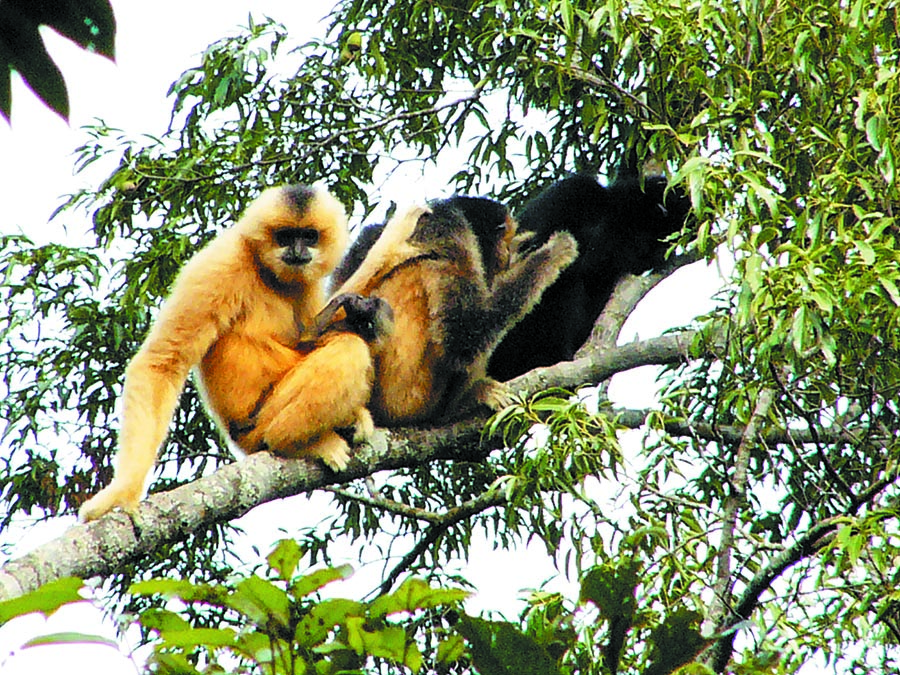
Popular feature of island life contributes significantly to its rich biodiversity, reports Chen Bowen in Haikou.
Zheng Haiqiang and Ni Decong rose early on Jan 24, before the break of dawn, to monitor Hainan gibbons. This was a routine task. After a one-hour hike, they heard the primates howling, located their positions, and excitedly found one holding a baby cub.
Since 2020, gibbon infants have been spotted each year, and, thanks to four decades of unrelenting conservation efforts, the population is thriving.
It has increased from seven gibbons across two family groups in 1980 to 36 split into five families in April, according to a report released at the 2022 Tropical Rainforest International Conservation Symposium held from Oct 24 to 25 in Haikou, Hainan province.

The Hainan gibbon, "the giant panda of Hainan", is endemic to the province. There are 20 gibbon species recognized worldwide, of which six are known to come from China. The Hainan gibbon is the most endangered of them all and one of the world's rarest primates. They can mainly be found in Bawangling National Nature Reserve in Changjiang county, western Hainan, which is part of the Hainan Tropical Rainforest National Park.
Previously, the life expectancy of a Hainan gibbon was around 30 years, but due to the improvement of their environment, they can now live up to more than 40 years, according to Qi Xuming, director of the Education and Publicity Division of Bawangling Branch of Hainan Tropical Rainforest National Park Administration. In recent years, staff members of the reserve administration have spotted a greater number of young, healthy gibbons.

Taking action
With increasing national investment in protecting the reserve and wildlife, Hainan gibbons now have a habitat covering an area of about 85,700 hectares, with over 300 staff members from the reserve patrolling the rainforest, observing and protecting the animals.
Great efforts have been made to recover and expand the habitats of the Hainan gibbons. They prefer to live in extensive, intact lowland primary rainforests, but the lumber industry and destruction of crops in the 1980s have pushed them to a higher altitude of about 800 to 1,000 meters. In these areas, there is less of their favorite food, like litchis, grapes, berries and banyan tree leaves. Now, however, thanks to plantation and afforestation, Hainan gibbons have started to return to their traditional lowland forest home, which offers more abundant food and warmer temperatures.
Forty years ago, Bawangling formed a monitoring team, which consists of forest rangers and experienced villagers. The mountain is patrolled twice each month, and each patrol will last for at least 10 days.
The members of the monitoring team, like Zheng and Ni, will get up at 4 am every day. Science and technology help to scope out and predict locations where they may be able to observe the gibbons, and then they'll wait for them to start howling at around 6 am, before taking photos and recording the lives of the gibbons. Hainan gibbons will shout loudly several times before 11 am.
"We tend to not interrupt the gibbons, but sometimes it's inevitable," says Qi. "Interestingly, different family groups show different traits. Some gibbons are already used to being tracked and are no longer afraid when members of the monitoring team approach gently to within two or three meters, while other groups remain wary."
Since 2019, more research institutes, such as Sun Yat-sen University, Beijing Forestry University and Hainan University, have conducted research on Hainan gibbons in the Bawangling National Nature Reserve, including studying their behavior, mating patterns, droppings and the sounds they make. International organizations, such as the Zoological Society of London, have shown an interest in the work.
A system of real-time monitoring and livestreaming may be adopted to allow more research institutes and the public to watch and follow the Hainan gibbons, according to the Bawangling National Nature Reserve.

Natural barometer
The Hainan gibbons are a critically endangered and important flagship species. Because of this, they serve as an indicator of the health and stability of the tropical island's entire ecosystem, according to Qi. "If the number of Hainan gibbons increases, it indicates that the local environment is healthy, complete and functioning well," Qi says.
Hainan gibbons also play a key role in forest maintenance and reforestation. With long arms and legs but no tail, they typically spend all their time in the trees and rarely set foot on the ground. They usually leap from tree to tree, making them an ideal vehicle for dispersal of seeds for primeval rainforest flora, as well as for the fruit they consume via their excrement. "That is to say, the population of Hainan gibbons is essential for the fecundity of native plant species," Qi says.
To educate people on the island's exclusive residents, exhibitions have been held in schools and communities across the province. From Oct 24 to 31, a science exhibition, Into the Mysterious "Gibbon Universe" of the Bawangling National Nature Reserve — the Familiar and Unfamiliar Facts of Hainan Gibbons was held at Hainan Library. With interesting, vivid and informative pictures and illustrations, the exhibition presented the living habits and population changes of Hainan gibbons, as well as the effects of conservation on the animal and its habitat.
The activity aims to raise awareness among the public, especially youngsters, and encourage them to learn more about the gibbons and forest conservation efforts.
Lei Leyan, a visitor in her 40s, attended the exhibition, and learned a lot of interesting facts about the creatures, such as their family roles and favorite foods, and the significance of protecting the species. "Hainan gibbons are a symbol of the province," she says. "Protecting them is crucial for a sustainable future. And Hainan is making contributions to the biodiversity of China and the world."
With that goal in mind, Qi says that he hopes more young people will join in the conservation efforts, for example, by becoming part of the monitoring team, like Zheng and Ni.
"Hopefully, with more education and publicity, the national park administration will recruit more talent, and young people with a relatively high educational background will join the monitoring team," Qi adds.














